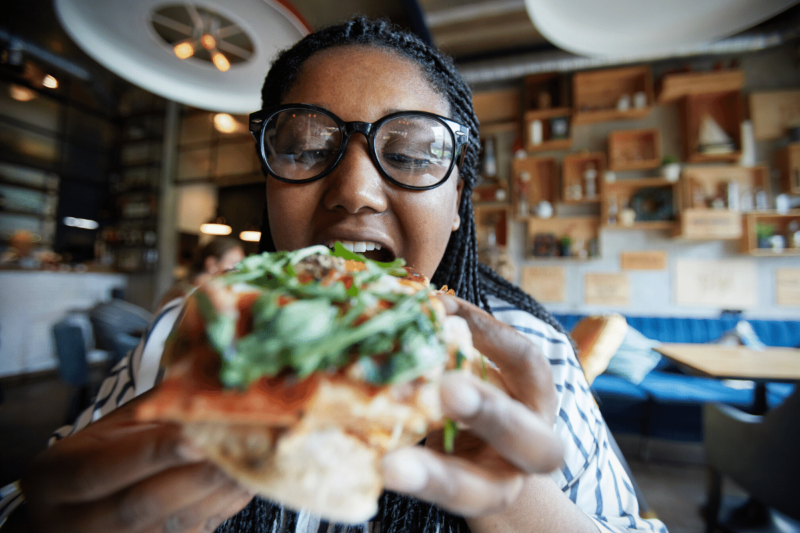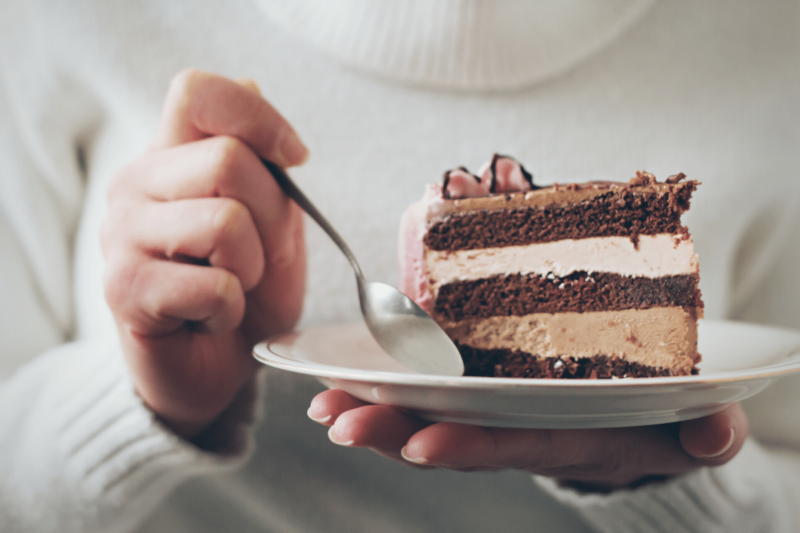
A question I get a lot is “How does pleasure work with intuitive eating?” The short answer is that if you are practicing intuitive eating in a way that honors the intention behind intuitive eating, then there’s plenty of pleasure.
You’ll notice I didn’t say, “If you are practicing intuitive eating correctly…”. That’s because there’s no one “right” or “correct” way to practice intuitive eating. That said, many people promote or practice it in a way that doesn’t honor the intention behind it.
- One example would be promoting intuitive eating for weight loss. (When someone practices intuitive eating, they might lose weight, they might gain weight, or they might stay at the same weight, depending on many factors).
- Another is turning the principles of “Honor Your Hunger” and “Feel Your Fullness” into something more along the lines of “You can only eat when you’re hungry and you have to stop when you start to feel full (or sometimes before you get full).” That’s not intuitive eating. The principles are guidelines, not rules.

What is pleasure?
What do we mean when we talk about pleasure? Eating chocolate cake is pleasurable (for most people, anyway), but if you eat so much chocolate cake that you have a stomachache, is that pleasurable? What if you ate nothing but chocolate cake for a week? You might not feel very good, and you would probably be so bored with chocolate cake that you never wanted to eat it again, a la Lucy and Ethel in the chocolate factory.
On the flip side, let’s say you eat, a nice piece of grilled salmon, with some roasted broccoli and a small sweet potato. You would experience the pleasure of satisfying your hunger, and fueling your body with a balance of nutrients that left you feeling energized afterward. And you might like salmon, broccoli and sweet potatoes.
But what if that was one of the few dinner combinations you allowed yourself?
What if you really wanted a slice of chocolate cake for dessert — a favorite treat that you haven’t had for a long time — but told yourself “No” because you weren’t hungry and because chocolate cake is “bad” for you.
In two of those scenarios, there’s pleasure to be had, up to a point. Then the pleasure is squelched by either excess or deprivation.
In the “Cake! Cake! Cake all the time!” scenario, the pendulum has swung far in one direction.
In the “salmon, broccoli and sweet potatoes all the time…and no cake for you!” scenario, it’s swung completely the opposite direction.
What we’re looking for is a middle ground. That’s the place where true pleasure lives. When you eat a VARIETY of nutritious foods that you also enjoy, and you mindfully enjoy “fun foods” like cake without guilt.

Hierarchy of food need
Intuitive eating draws from a number of sources, including the work of Ellyn Satter, who developed the Hierarchy of Food Need (a twist on Abraham Maslow’s hierarchy of needs). Starting from the bottom, or most essential need, you have:
- Enough food. If you are food insecure, on a restrictive diet, or stuck somewhere without so much as an emergency snack bar in your bag or purse, then getting enough food is priority one.
- Acceptable food. Once you have enough food, do you have enough acceptable food? This is the type of food you prefer, and food preferences vary from person to person.
- Reliable access to food. Do you know you will have enough food, ideally enough of your preferred foods, tomorrow? Next week? Lack of reliable access to food is why people who can only afford to grocery shop once a month, or who go on and off restrictive diets, are vulnerable to binging when access to food resumes. That access might be granted by yourself or by a new allotment of food stamps.
- Good-tasting food. Once you have enough food, you become more particular about your food, prioritizing enjoyment. This makes eating for pleasure easier.
- Novel food. Once you’re use to having enough food, and enough of your favorite foods, you will probably want more variety. You might try new foods, or try eating favorite foods prepared in different ways. This enhances sensory pleasure further, and it also can make your overall diet more varied and nutritious.
- Instrumental food. This is the category of food that you might consider “good for you.” It’s also the only tier that dietary recommendations pay attention to. Ironically, not forcing yourself to eat fruits and vegetables allows them to become foods you eat for pleasure. As Ellyn told me once, “People eat nutritious food because they enjoy it, not because they have to. The bedrock is that you enjoy eating and feel good about it.”

Eating for pleasure and satisfaction
Now let’s circle back to intuitive eating. Once you ditch the diet mentality (Principle 1), you can start making peace with food. This includes internalizing the fact that there are no “good” foods and no “bad” foods, in a moral sense. You’re not “good” because you eat a “good” food or “bad” because you ate a “bad” food. As Evelyn Tribole, co-author (with Elyse Resch) of the book “Intuitive Eating: A Revolutionary Anti-Diet Approach,” often says, it’s true that an apple and a slice of apple pie are not nutritionally equivalent, but they ARE morally equivalent.
When you make peace with food, and accept that you can have a cookie anytime you want a cookie, you won’t suddenly start eating cookies all day, every day. (One caveat: depending on your level of prior deprivation, there may be an initial “honeymoon” period where you are eating a lot of the foods that you had previously defined as “bad” or off-limits). You’ll actually become choosier.
If you can have a cookie anytime you want a cookie, why would you eat a stale cookie, or that cheap grocery store cookie that someone brought into work?
After all, you could get a cookie from that fabulous bakery down the street if you really wanted one right now. Or you could plan to bake cookies at home, without stressing that you’ll wolf down a dozen in a sitting? Why? Because you’re no longer doing a land grab whenever a “forbidden” food crosses your path. This enhances pleasure and satisfaction, because you’re not just having any cookie, you’re having the kind of cookie you really want, at a time when you truly want it.

Finding food pleasure where you wouldn’t expect it
Food is fuel, food is pleasure. Ideally you get both in the same meal, but that doesn’t always happen, and that’s OK. There’s pleasure in all three scenarios:
- Fueling your body well,
- Mindfully savoring a delicious desert.
- Enjoying a delicious meal with or without dessert as a finisher
One you’ve reached the point of allowing yourself pleasurable, formerly forbidden foods, they become less of a big deal. You become freer to find pleasure from all sorts of foods, nutritious foods and “fun foods.”
That involves checking in with yourself about what would feel good and taste good. Do you want hot or cold? Crisp or creamy? Hearty or light? Cooked or fresh? Do you need your meal or snack to keep you satisfied for two hours, or four? Your answers will guide your choice, and make your meal or snack more pleasurable on more levels than simply taste.
For example, when it’s summer and you’re sitting outside eating a cool, crisp salad for lunch, that’s pleasurable. When it’s extra chilly outside and you’re curled up inside with a comforting bowl of soup or a cup of tea, that’s pleasurable.
You could say that intuitive eating helps you find the pleasure of truly nourishing yourself. And something I’ve seen over and over again is that when people embrace the practice of intuitive eating, they start nourishing themselves better in ways that have nothing to do with food, specifically. Setting boundaries. Trying that new yoga or dance class. Going for a walk because they want to, not because they “have to.”
I hope that answers the question!
This post contains Amazon Affiliate links. As an Amazon Associate I earn from qualifying purchases.
Carrie Dennett, MPH, RDN, is a Pacific Northwest-based registered dietitian nutritionist, journalist, intuitive eating counselor, author, and speaker. Her superpowers include busting nutrition myths and empowering women to feel better in their bodies and make food choices that support pleasure, nutrition and health. This post is for informational purposes only and does not constitute individualized nutrition or medical advice.
Seeking 1-on-1 nutrition counseling? Learn more about her Food & Body, IBS management, and nutrition counseling programs, and book an intro call to see if the program is a good fit, and if we’re a good fit!
Want exclusive content on nutrition, health, diet culture and more, plus critiques of nutrition and health journalism? Subscribe to my Food Noise newsletter! 📣






